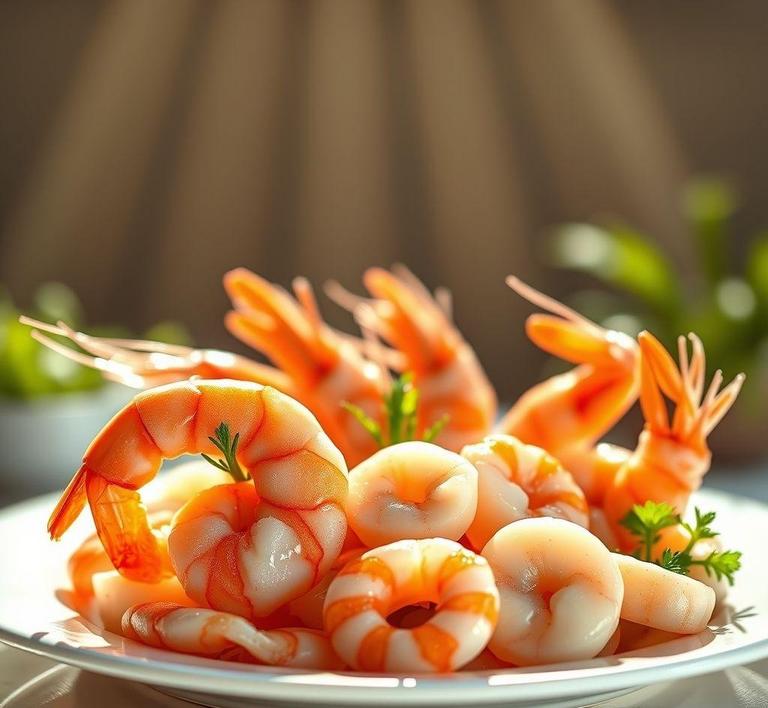If you’ve ever found yourself with a bag of shrimp or scallops that you couldn’t finish, you might wonder if it’s safe to refreeze them. The good news is, yes, you can refreeze shrimp and scallops, but there are some key things to keep in mind to preserve their quality and taste. When done right, you can safely store them for later use without compromising their texture or flavor. In this guide, we’ll walk you through the best practices for refreezing these seafood delicacies, ensuring you avoid common pitfalls like freezer burn or mushy textures.
Can You Refreeze Shrimp And Scallops?

The short answer: Yes, you can refreeze shrimp and scallops-but with caveats.
Shrimp and scallops are delicate seafoods, both high in protein and low in fat. Their cellular structure and moisture content make them particularly sensitive to temperature fluctuations. This means that while refreezing is technically possible, it must be done under strict conditions to ensure both safety and quality.
The key condition for safe refreezing is this: the shrimp or scallops must have been thawed safely in the refrigerator, not at room temperature or in warm water. When thawed slowly in a cold environment (below 40°F/4°C), the risk of bacterial growth is minimal. In contrast, seafood left out for more than 2 hours at room temperature can enter the "danger zone" (40°F-140°F), where bacteria multiply rapidly. In such cases, refreezing is not recommended due to potential foodborne illness.
So, if you’ve thawed your shrimp or scallops in the fridge and haven’t left them out too long afterward, it is safe to refreeze them.
How To Refreeze Shrimp And Scallops?
Refreezing seafood properly is not as simple as tossing it back into the freezer. Follow these steps to maximize safety and preserve as much quality as possible:
-
Pat Dry Before Freezing:
Excess moisture can lead to freezer burn, which dries out seafood and affects both flavor and texture. Gently pat the shrimp or scallops dry with a paper towel before refreezing.
-
Portion Before Freezing:
Divide your seafood into meal-sized portions. This reduces the need to refreeze repeatedly, which would further degrade quality.
-
Wrap Properly:
Use airtight, freezer-safe bags or vacuum-seal your seafood. If using bags, squeeze out as much air as possible. Wrap them in an additional layer of aluminum foil or place them in a rigid container for added protection.
-
Label Clearly:
Mark the packaging with the refreezing date. Seafood generally maintains the best quality for up to 1-2 months after being refrozen.
-
Freeze Quickly:
Place the seafood toward the back of the freezer where the temperature is most consistent. The faster the food freezes, the fewer ice crystals form, which helps preserve texture.
Quality Impact
Now, let’s address the elephant in the freezer: quality. While refreezing seafood is safe under the right circumstances, it does come at a cost.
-
Texture Degradation:
The freezing and thawing process causes the water inside shrimp and scallop cells to expand into ice crystals, rupturing the cell walls. When refrozen, this process repeats, leading to mushy or rubbery textures upon cooking.
-
Flavor Loss:
With each cycle of freezing and thawing, delicate flavors begin to fade. The seafood may become bland or take on a slightly ‘off’ taste if not refrozen quickly and correctly.
-
Visual Changes:
Discoloration and frost accumulation (freezer burn) are more likely on refrozen seafood, especially if not wrapped properly.
To mitigate these issues, consider using refrozen shrimp and scallops in recipes where texture is less critical-like soups, stews, paellas, or seafood casseroles. These dishes rely more on integrated flavors than on the pristine presentation of the seafood itself.
Yes, you can refreeze shrimp and scallops-but only if they’ve been thawed properly in the refrigerator and haven’t lingered at room temperature. The process must be done with care: dry them, portion them, wrap them tightly, and label them for future use. Keep in mind that while safe, refreezing does compromise the delicate texture and nuanced flavor of these marine delicacies.
If you prioritize peak quality-firm, tender bite and sweet ocean flavor-it’s best to cook thawed seafood immediately. But in the real world of shifting meal plans and leftovers, knowing how to safely refreeze can help reduce waste without sacrificing too much on the culinary front.
Is It Safe To Refreeze Shrimp And Scallops?
The short answer is yes – under specific conditions, it is safe to refreeze shrimp and scallops. However, the key lies in how they were thawed, how long they’ve been at room temperature, and the integrity of the cold chain (the temperature-controlled supply chain from harvest to your freezer).
If you’ve thawed your shrimp or scallops in the refrigerator – keeping them below 40°F (4°C) the entire time – you can refreeze them safely without risking foodborne illness. But this comes with a caveat: while it may be microbiologically safe, the quality can suffer. Freezing causes water within the muscle fibers to expand into ice crystals, which can rupture cell walls. Refreezing this already-thawed protein can double the damage, leaving your seafood rubbery, mushy, and less flavorful.
On the other hand, if shrimp or scallops were thawed on the counter, in warm water, or left sitting out for more than two hours, they should not be refrozen. At those temperatures, bacteria multiply rapidly, even if the product still looks and smells acceptable.
Signs That Shrimp And Scallops Should Not Be Refrozen
To protect your health and palate, it’s important to recognize when shellfish should be discarded instead of refrozen. Here are the most telling warning signs:
-
Off Odors:
Fresh shrimp and scallops have a clean, briny scent reminiscent of ocean water. If you detect a sour, ammonia-like, or overly fishy smell, this indicates bacterial decomposition – and refreezing is not safe.
-
Discoloration:
Shrimp should be translucent with a slight gray or pink hue, depending on whether they’re raw or cooked. Scallops should be creamy white. Black spots, yellowing, or dullness may indicate spoilage or oxidation.
-
Slimy Texture:
A naturally slick surface is normal, but a thick, sticky, or tacky residue is a sign of bacterial activity. If the texture feels slippery rather than slightly moist, err on the side of caution and discard it.
-
Ice Crystals or Freezer Burn:
If previously frozen shellfish shows excessive ice crystals or white, dry patches (freezer burn), it’s a sign it has been improperly stored or thawed and refrozen already. While not necessarily unsafe, the quality is significantly degraded, and refreezing it again would be futile.
Common Refreezing Mistakes
Despite the best intentions, home cooks often make missteps when handling seafood. Here are the most common refreezing mistakes and how to avoid them:
-
Refreezing After Counter Thawing:
Thawing shrimp or scallops on the kitchen counter is a health hazard. Even if the center feels cold, bacteria may have rapidly multiplied on the outer layers. Never refreeze anything that wasn’t kept below 40°F during thawing.
-
Repeated Freeze-Thaw Cycles:
Constantly thawing and refreezing seafood causes severe moisture loss and cellular breakdown, leading to tough, unappetizing textures. Once is manageable; more than that turns your gourmet ingredients into rubbery remnants.
-
Using the Wrong Containers:
Freezing seafood in subpar or loosely sealed containers allows air to infiltrate, causing freezer burn. Always store in airtight, vacuum-sealed bags or heavy-duty freezer-safe containers to maintain moisture and prevent oxidation.
-
Forgetting to Label:
Without clear labeling, it’s easy to lose track of how long your seafood has been frozen or if it has been thawed and refrozen. Always write the date of freezing and any thawing notes on the packaging.
Tips And Tricks
Refreezing doesn’t have to be a death sentence for your seafood. With a bit of preparation and knowledge, you can safely refreeze shrimp and scallops with minimal loss in quality.
-
Quick Freeze Technique:
If you must refreeze, do it as quickly as possible. Place seafood in a single layer on a metal baking sheet in the coldest part of your freezer. Once fully frozen, transfer to a vacuum-sealed bag or airtight container. Fast freezing minimizes ice crystal formation and protects texture.
-
Use Cold Water to Thaw:
For a quicker (but still safe) method, thaw seafood in a leak-proof bag submerged in cold water. Change the water every 30 minutes. Once thawed, cook or refreeze immediately.
-
Cook Before Refreezing:
If you’re concerned about quality loss, cook the shrimp or scallops first. Fully cooked seafood can be frozen again with less concern about texture, as cooking sets the protein structure. Just note: reheated cooked seafood has a shorter freezer life – ideally used within 1 to 2 months.
-
Freeze in Portions:
Instead of thawing a whole pound of shrimp when you only need a few pieces, divide your seafood into smaller meal-sized portions. This reduces waste and the temptation to refreeze leftovers.
Conclusion
Refreezing shrimp and scallops isn’t inherently dangerous, but it requires mindful handling to preserve both safety and flavor. If the seafood was thawed properly – in the refrigerator and kept at safe temperatures – you can refreeze it once without worry. However, repeated thawing, poor storage methods, or signs of spoilage should never be ignored. When in doubt, toss it out – no meal is worth a foodborne illness.
By following safe practices and staying vigilant for spoilage signs, you can ensure that your seafood remains a delightful, not dangerous, addition to your table. Whether it’s a buttery pan-seared scallop or a succulent shrimp cocktail, freshness is key – and now, you’re better equipped to keep it that way.


